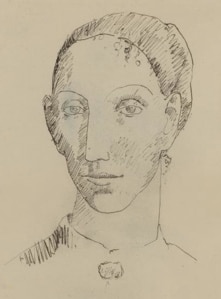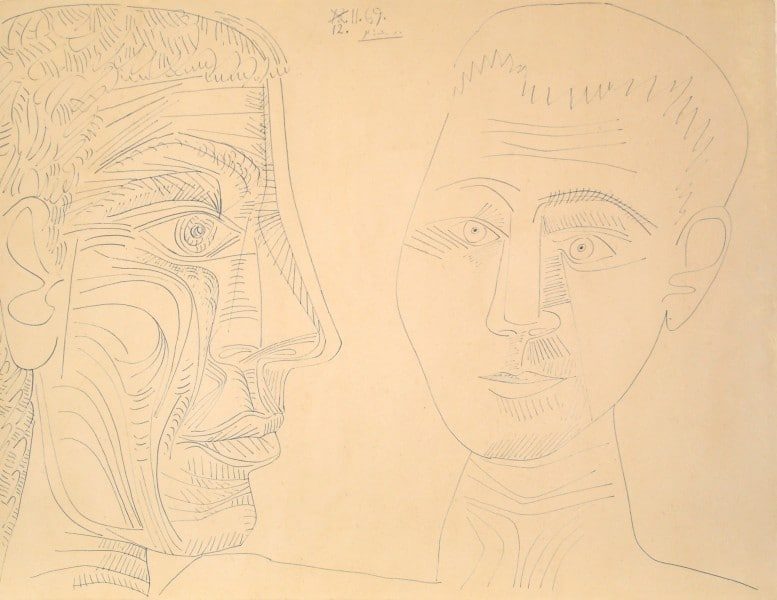Two Heads
Artist: Pablo Picasso (1881-1973)
Date: November 12, 1969
Medium: Fountain pen with blue ink on buff-colored paper
Dimensions: 508 x 657 mm, 20 x 25 7/8″
Signature: Signed “Picasso” and dated, top center
References:
• C. Zervos, Pablo Picasso: Oeuvres de 1969, Paris, 1976, vol. XXXI, no. 494, illustrated p. 153.
• H. Chip and A. Wofsy, The Picasso Project : Picasso’s Paintings, Watercolors, Drawings and Sculpture: A Comprehensive Illustrated Catalogue 1968-1969, San Francisco, 2003, no. 69-498, illustrated p. 268.
• Mallen, Enrique, ed. Online Picasso Project. Sam Houston State
University. 1997-2017. OPP.69:111 ills.
Provenance:
• Sala Gaspar, Barcelona
• Private collection, Paris
• Sotheby’s London, June 20, 2006, lot 223
Price: Sold
In his eighties and nineties, Picasso faced up to his own mortality by racing against time and creating art at an even more frenetic pace than before. A few key themes possessed him during these last years, including the nude, the artist and his model, the musketeer, the bordello, and some of his favorite Old Master paintings. He created countless iterations on these subjects, and much has been written about them. In this drawing, however, he digressed. There is nothing in his late work, and very little in his earlier work (see below), that is comparable, either stylistically or thematically. The manner of modeling and shading of each of these portraits, though identifiably Picassian, is nonetheless unique in his oeuvre, and also quite inventive. How typical of Picasso to create a new style du jour in a single work, and then move on to the next style, or revert to a former one, the next time he lifted a pen to paper.
In his late years, although many of his depictions of men could be considered allegorical self-portraits, they very rarely bear any actual resemblance to him, apart perhaps from their often bald pates. It has been argued that he painted stand-ins for himself in the guise of Rembrandt, van Gogh, or, more commonly, a fanciful musketeer. This interpretation is speculative, since of course he didn’t necessarily have to identify with any of these people in order to paint them. In our drawing, however, he contemplates two visages, one recognizable as a self-portrait of the artist as a young man, again a portrayal unique in the artist’s later work. The eyes, nose, mouth, and strong jaw, if not the curly hair, are clearly Picasso. The most famous late self-portraits are the two “death masks” of June and July, 1972 (Z. XXXIII, 435 and 436), which portray the moribund artist with a triangle poignantly missing from his skull where a lock of hair had lain in his youth.
Whereas the other self-portraits depict an aged, bald, and wrinkled Picasso, this drawing uniquely finds Picasso contemplating his youthful features in their prime. This self-portrait exudes inner strength and power, and self-assurance. Yet this visage also strongly expresses a certain hesitance and uncertainty, even sadness. The aged artist, with but three years left onstage, is taking full measure of his life, wistfully contemplating his youth and looking ahead to his unavoidable fate.
Collectors looking for self-portraits of Picasso don’t have many choices. Apart from the possible stand-ins such as sundry artists and Minotaurs, there are very few recognizable self-portraits, except, interestingly, both very early and very late in his career. And the vast majority of the late recognizable or so-titled self-portraits are prints. Most of the other self-portraits have already made their way into museum collections. The number of recognizable and/or titled self-portraits in the mediums of painting and drawing in L’époque de Jacqueline, essentially the last 20 years of his life, are seven (by my count, using Wofsy, the Online Picasso Project, and Picasso and Portraiture as references). In addition to our drawing, this count includes two paintings in which Picasso’s presence is suggested by just a non-descript shadow and the bearded Autoportrait of April 3, 1965 (Z. XXV, 95), which I have to believe was somehow mistitled, as Picasso did not wear a beard. Picasso rarely titled his works himself but generally left the task to his dealers, primarily Kahnweiler, subject, as it’s been said, to Picasso’s approval. It is impossible to know whether the designation of autoportrait or the inclusion of Picasso’s name in the title of a given work indisputably means that the artist meant it to be a self-portrait. But the opposite argument is clearly unsupportable, namely, the significance of the lack of the term “self-portrait” in the title. One merely has to consider the thousands of portraits of his wives and lovers that are indisputable in their subjects and yet usually bear general titles such as Tête de femme.
As for the concept of stand-ins, carried to its absurd conclusion, all the portraits of fictitious and actual artists (e.g. Degas, Rembrandt, Rafael), as well as smokers, other mythical creatures, bulls, primates, even the depictions of Jesus, men in general for that matter, not to mention primates and primates-as-artists, stand-ins for Picasso? We’ve encountered Picasso’s quote regarding the Minotaur (“If all the ways I have been along were marked on a map and joined up with a line, it might represent a minotaur”), but wasn’t he just speaking allegorically at best, and, at worst, just goofing on his conversant? Sure, many of these subjects could be considered self-referential up to a point, but in a stricter sense, the self-portraits are the ones that actually look like him, unless of course there’s some other reason to believe that they are self-portraits, such as their titles.
The portrait on the right is just as accomplished artistically and exposes just as powerful a persona, despite the comparative economy of line. Picasso leaves no hints as to its identity or the source of his inspiration for this bust. We can just make out the Spanish features, perhaps, of this bony youth. Even this subject’s gender is uncertain. Its face is effeminate, but the incipient male-pattern baldness, the somewhat muscular neck, and the broad shoulders suggest masculinity. It could of course be Jacqueline, certainly the default choice for any female portrait during the Jacqueline epoch. Since it bears at most a passing resemblance to her (though no less so than many other presumed portraits of his wife), it could also be read as that of another woman, or of a young man, in dialogue with Picasso. Perhaps this figure represents a male friend from his youth, a long unseen or forgotten comrade about whom he had just reminisced, which inspired him to get it down on paper, alongside his youthful self-portrait. Whoever it is, this androgynous figure, like the self-portrait, conveys inner strength and wisdom, and in addition an expectant look in the eyes and a subtle smile playing on the lips.
Picasso has been called the “best psychologist of the twentieth century”. The thoroughness of his characterizations in this drawing is so complete that after studying their faces, we think we know these people.
Picasso had an encyclopedic knowledge of preexisting art, from which he borrowed mercilessly in later years. He also sampled his own art upon many occasions, especially in his final years when he was rather given to nostalgia. The figure on the right in the drawing at hand perhaps bears more than a passing resemblance to a portrait he had drawn of a woman in Gosol, in the Spanish Pyrenees, where he summered in 1906. A detail of this a 1906 pen and ink and blue crayon drawing, Tête de Femme, Gosol (Zervos XX, 448), is shown below. (PIease note that it is a slightly smaller drawing which nonetheless broke the million dollar mark at auction in 2006.) I suppose, however, that the resemblance is more likely just a coincidence….

Late Picasso paintings have broad brushstrokes and consequently an indefinite line, and most late Picasso drawings look sketchy with their fast, indistinct depictions. By contrast, the large, masterful ink drawing at hand, more so than the vast majority of drawings of his last decade, demonstrates that Picasso, at 88, could still draw with precision and clarity, as much as ever. This drawing as well as several others Picasso executed the same day and the following day were rendered in fountain pen with a pleasing Mediterranean blue ink, an unusual ink in his oeuvre. The photograph above poorly conveys this color, just as it fails to represent the somewhat variable width of the strokes of his pen, rather calligraphic in appearance. When viewed “in the flesh”, this wonderful drawing commands a striking presence.
Unlike his unerring line, however, Picasso apparently lost track of time on the day he created this drawing. He had been precisely dating his works for decades as a nod to posterity, fully aware of his place in history and of the tomes of art criticism that his works would engender. This drawing and the two others he produced the same day all show the initial dating of November 13, with the “13” subsequently X-ed out and underscored with a “12”.
